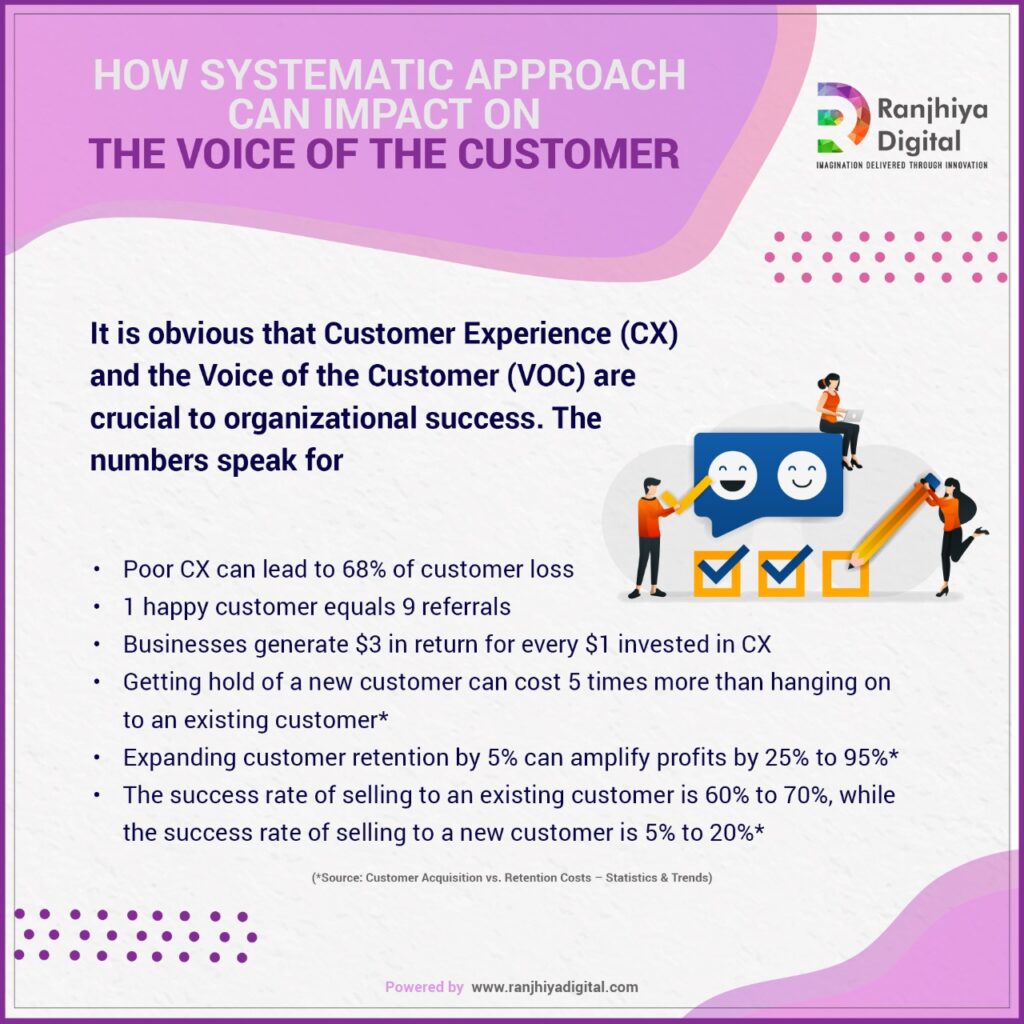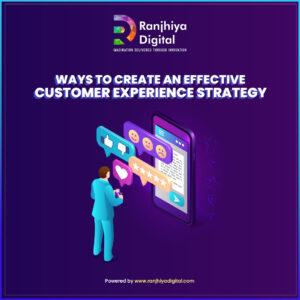What is your VOC approach? Are you listening to customers, or still just Hearing ?
Conventionally, VOC (voice of the customer) has been captured by surveys or some other form of structured feedback, initiated by any company. Gradually, as VOC (and tools and technology for both companies and customers) has evolved, listening has become a vital role in the program; this simplifies that the customer provides feedback on his terms, which is typically initiated by him in response to some interaction.
Listening include 360 degree coverage starting from social media (Twitter, Facebook, Instagram etc.), customer immersion, customer advocacy, voice of the customer through the employee (sales, customer service, etc.), CRM data and more.

Here’s how Systematic Approach can impact on the Voice of the Customer:
It is obvious that Customer Experience (CX) and the Voice of the Customer (VOC) are crucial to organizational success. The numbers speak for themselves:
• poor CX can lead to 68% of customer loss
• 1 happy customer equals 9 referrals
• Businesses generate $3 in return for every $1 invested in CX
• Getting hold of a new customer can cost 5 times more than hanging on to an existing customer*
• Expanding customer retention by 5% can amplify profits by 25% to 95%*
• The success rate of selling to an existing customer is 60% to 70%, while the success rate of selling to a new customer is 5% to 20%*
(*Source: Customer Acquisition vs. Retention Costs – Statistics & Trends)
When companies listen instead of asking, the client is then in the VOC driver seat. Customers give feedback on their terms – when, where and how they prefer e.g., social media, review sites or in the discussions with employees. This adds a social element – it’s no longer just between the customer and the console or the customer and the interrogator – and doesn’t allow companies to push feedback in a wrapper somewhere, which is never to be seen again.
On the contrary, it initiates the companies to pay attention, though we find that many still don’t. Querying for feedback is like lobbing a question over the net, while listening is more like volleying. Asking puts the burden on the customer while listening puts the onus on the company.
Certainly, Surveys can categorize or quantify the voice. Listening adds the depth and profundity, i.e., what they want or how they interact, which provides the opportunity to innovate.
Listening to the customer requires both an organised and comprehensive approach—organised to ensure uniformity and constancy and comprehensive to ensure there are no unintentional blind spots that distorts analyses and leave customers by the wayside. In order to achieve both, there are three primary areas of VOC analysis to consider.
1. Using All Sources of Data – Many counterintuitive or misaligned conclusions and recommendations between sources will be there, but only one or two may be used to make a decision. Thereby, how do you know which data to listen to or what is it telling you about your customer and where do you go from there!
Each data sources contains valuable information. But until a more comprehensive picture is assembled to manifest why and how customers are making decisions to disclose the rudimentary reasons for seemingly conflicting conclusions, organizations are stuck making decisions based on only one lens of customers—and certainly only one component. An organization’s data is most valuable when its multiple sources can be analysed together to gain a fuller, 360-degree view of the customer. This avoids exiting groups of customers out of the conversation and enhances alignment across sections for a more coordinated approach to achieving organizational goals.
2. Breaking Down Silos – a problem closely associated with examining all sources of knowledge is removing data silos. so as to look at all data sources, organizations must first be ready to access the multiple sources and compile the info together. To do so, they need to have the infrastructure to deal with multiple data sources—such as a knowledge warehouse or data lake—to enable quick access, combination, and extraction of knowledge.
3. Utilizing Customers’ Native Expressions of Feedback –
Before the arrival of text analytics software, organizations had to believe simple survey questions with numeric scaled responses (so-called “structured” questions) to capture customer feedback about effort, likes and dislikes, and pain points. While such questions provide some insight, they come short in several key areas, which may undermine an organization’s ability to really hear its customers:
Limited Number of Response Options – Structured questions that ask respondents to select a solution from a limited number of responses force respondents to pick the simplest option—even if it doesn’t fit their answer or fully capture their intended response.
Loss of Depth & Nuance
Similarly, structured questions don’t capture specific reasons and instead tend to bucket related responses together into general categories. The broad nature of those categories makes it difficult to derive insights that are specific enough to tell decisions and drive action.
Prioritizing the Organization’s Agenda Over Customer Concerns
Trying to see into customers’ underlying thoughts via structured questions requires prompts that always force respondents to reframe their thoughts to match those areas that are of interest to the organization—not to surface what’s top of mind to the purchasers. This causes organizations to miss the items that are most vital to customers also as their thoughts about them.
Capturing unstructured Data and Social Media data and Listening to it with in-depth analysis to have deep insight through appropriate Tools and implementation skill with Knowledge and then collating with other Data source of customer feedback is vital.
In the end, sharing the results of systematic listening efforts and success stories across the organization further bolsters an organizational orientation to the customer, promotes the sharing of ideas, and prevents departments or segments from resurrecting old silo walls. By adding the system to “systematic listening,” organizations can repose on their efforts within and across departments to put the customer at the centre of the conversation and ensure alignment to shared goals and strategy.
Since, there’s a proverb, a cheerful customer tells a friend; an unhappy customer tells the planet.
At Ranjhiya Digital (www.ranjhiyadigital.com), for our clients, we practice advance level of Listening of structured & non-structured Data to understand VoC and have deep insight into Feedback/VoC Data to suggest the right course of action to fulfil Organizational objectives.











